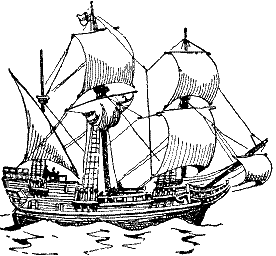|
One Busy Guy Presents.... About the Mayflower
Such a ship was
manned by a crew of about 18. Passengers numbered 102. The religious right
(41) referred to themselves as 'saints' and to the remainder of the group (61)
as 'strangers' for a total of 120 persons on board (30 were children).
There are also two dogs. Food consisted of hard baked biscuits and salted beef
with porridge and beer. Nearly
everyone suffered from sea The spirit of the Mayflower is further immortalized in the name of this lovely blossom, also the State flower of Massachusetts. In the voyage of 1620 the oldest person was born in 1556 (James Chilton). The tale of this crossing would include a hanging, accidental drowning and a great suffering in the first year. Indeed, half the ships company succumbed before the first anniversary. Many passengers paid nothing towards their fare and agreed in exchange to work for their passage. The ship sailed on September 16 arriving at Plymouth Rock (Cape Cod) on November 19 of 1620. That date concludes some five weeks wherein the vessel explores the coast before proceeding ashore. Captains on board include Captain Christopher Jones (Master), and Captain Miles Standish. Plymouth Rock is more a symbol than a reality. It was an accommodation resulting from yet a third relocation of the Mayflower. The first shore excursion deploys several men to look for fire wood and food. They also return with juniper branches and use them to 'fumigate' the ship. Explorations reveal numerous sacred Indian burial mounds that the explorers raid for food and trinkets thus creating a good deal of animosity with the locals! It took 31 days to make the crossing back to England and the ship was safe in harbor on May 6 of 1621. In good condition the ship would be valued at around £700 (pounds sterling). At the time of its' retirement the ship was valued at only about £128. It was worth more as kindling that being scarce at the time. HOME Go to our Thanksgiving Page
* All figures are not well known and are presented as best estimates.
|
 The
Mayflower associated with US history was really quite tiny being 90 feet long
and only about 24 feet wide. The hold was a mere 11 feet deep. The vessel
sported three masts and weighed in at 180 ton
(by
way
of
contrast today's vessels
typically
exceed
70,000 ton). The Mayflower was low in the middle
and thus low in the water (especially when full). The fore and aft sections were
high making the middle susceptible to splashing waves and currents. Sailors of
the day referred to this design as a 'wet ship'. Originally the Mayflower
was to leave for the New World with a companion vessel the 'Speedwell'.
Unfortunately the 'Speedwell' leaked at mast bottom and returned to port twice
for repairs before the decision was made to send the Mayflower on alone.
The
Mayflower associated with US history was really quite tiny being 90 feet long
and only about 24 feet wide. The hold was a mere 11 feet deep. The vessel
sported three masts and weighed in at 180 ton
(by
way
of
contrast today's vessels
typically
exceed
70,000 ton). The Mayflower was low in the middle
and thus low in the water (especially when full). The fore and aft sections were
high making the middle susceptible to splashing waves and currents. Sailors of
the day referred to this design as a 'wet ship'. Originally the Mayflower
was to leave for the New World with a companion vessel the 'Speedwell'.
Unfortunately the 'Speedwell' leaked at mast bottom and returned to port twice
for repairs before the decision was made to send the Mayflower on alone. sickness. There was no bathing nor was there laundry.
sickness. There was no bathing nor was there laundry.